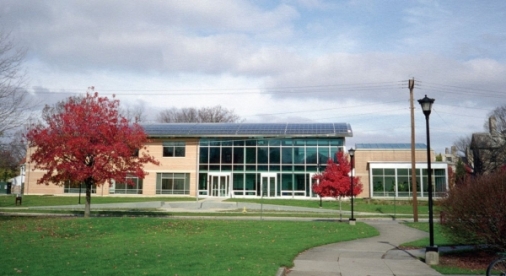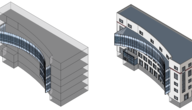You are here
An increasingly popular goal for green building is achieving Net Zero Energy - when your building is energy efficient and generates enough energy on-site to equal its annual energy needs.
|
|
Net zero energy buildings are highly energy-efficient and will use, over the course of a year, renewable technology to produce as much energy as they consume from the grid. This image of a photovoltaic array on the roof of the Lewis Center at Oberlin College in Oberlin, Ohio is courtesy of the National Renewable Energy Laboratory (ASHRAE) |
For high performance building design, it’s most useful to measure and compare designs using absolute energy and resource metrics. These comparisons are objective, universally applicable, and apples-to-apples.
When your design is guided by expected energy use and emissions, the true performance of the building is not filtered through any building code or green building rating system. While exceeding codes and pursuing rating systems like LEED is certainly helpful, it can sometimes obscure priorities. Because those priorities often boil down to energy effectiveness (see Environmental Impacts of Buildings), striving for Net Zero Energy is a very good design goal.
Definitions for Net Zero Energy Buildings
Net Zero Energy Buildings are highly energy-efficient buildings that will use, over the course of a year, renewable technology to produce as much energy as they consume from the grid. There are several definitions of “Net Zero” buildings – based on where you place the boundaries for the energy balance. Here’s a summary of the main definitions from NREL.
|
Net Zero Site Energy: A site NZEB produces at least as much renewable energy as it uses in a year, when accounted for at the site. Net Zero Source Energy: A source NZEB produces (or purchases) at least as much renewable energy as it uses in a year, when accounted for at the source. Source energy refers to the primary energy used to extract, process, generate, and deliver the energy to the site. To calculate a building’s total source energy, imported and exported energy is multiplied by the appropriate site-to-source conversion multipliers based on the utility’s source energy type. Net Zero Energy Costs: In a cost NZEB, the amount of money the utility pays the building owner for the renewable energy the building exports to the grid is at least equal to the amount the owner pays the utility for the energy services and energy used over the year. Net Zero Emissions: A net zero emissions building produces (or purchases) enough emissions-free renewable energy to offset emissions from all energy used in the building annually. Carbon, nitrogen oxides, and sulfur oxides are common emissions that ZEBs offset. To calculate a building’s total emissions, imported and exported energy is multiplied by the appropriate emission multipliers based on the utility’s emissions and on-site generation emissions (if there are any). |
Designing Net Zero Energy Buildings
The key to designing net zero energy buildings is first reducing energy demand as much as possible, and then choosing good energy sources. Here’s a simple “order of operations”...
1. Reduce energy loads
2. Optimize design for passive strategies
3. Optimize design of active systems
4. Recover energy
5. Generate energy on-site
6. Buy energy/carbon offsets
Along this course, you will dive into more specifics of how to do this.
Links and References
- This study by NREL shows the design impacts of the definition used for ZEB and the large difference between definitions.
- This article by NREL provides an overview of the DOE’s efforts toward realizing cost-effective net-zero energy buildings (NZEBs).
- Profiles of commercial buildings that produce as much energy as they use over the course of a year. A subset of the High Performance Buildings Database.
- This USDEO database collects information on the design of high performance buildings all over the world buildings around the world.
- US Federal Agenda for Net Zero Energy, High Performance Green Buildings
- A paper published in the ASHRAE Journal that examines the feasibility of Net Zero Energy buildings.



